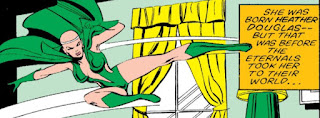For the fourth consecutive year, I decided to reread and blog about Seduction of the Innocent, Fredric Wertham's influential tome attacking the comic book industry. One argument that I previously overlooked was Wertham's belief that the abundance of illustrations within comic books stifled the imagination, as evidenced by children reproducing graphic images from comic books in their own drawings.
In Wertham's opinion as a psychiatrist, comic books lacked the constructive escapism often found in fairy tales. He cited reports of boys hurting themselves by leaping from high places while pretending to be superheroes. He added that even comic books extolling the dangers of drug addiction invariably taught children how to use heroin and other narcotics. Such hazards, according to Wertham, were compounded because comic books were themselves habit-forming. At the time of his writing in 1954, approximately 90 million comic books sold each month in the United States.
While conceding that other factors might also contribute to juvenile delinquency, Wertham cautioned adults against underestimating the negative impact of comics. The following excerpt from Seduction of the Innocent comes from the closing paragraph of Chapter II:
| | Once in the waiting room of the Clinic I saw a little boy crouched over a comic book, oblivious to everything around him. In passing I could see the title of this story he was reading. Big capitals spelled out T A R Z A N. Surely, I thought, the adventures of Tarzan are harmless enough for juveniles of any age. But I was misled, as many parents no doubt are. … Tarzan was not the whole title of the story I had seen the boy in the waiting room reading. There was a subtitle "The Wyoming Killer" and two other headings, "From Police Files" and "A True Crime Story." The story was not about Tarzan, but about a hero who robbed a bank and shot five men to death. |
|
Over the past century, several companies did publish comic books based on the Tarzan novels of Edgar Rice Burroughs. Marvel's monthly Tarzan series ran 1977-79.



































































